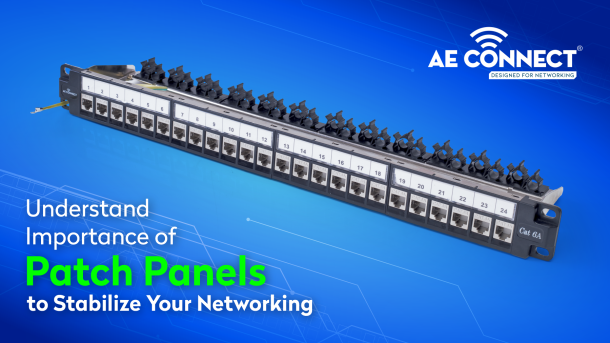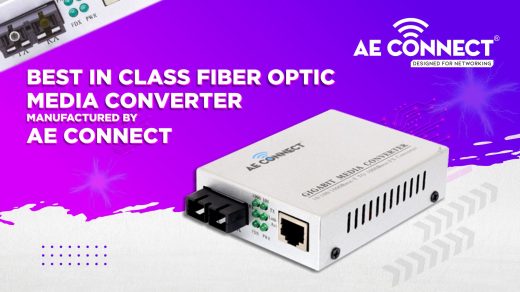Patch Panel High-density cabling systems are the necessity of modern networking infrastructure. Cost-effective and easy-to-use cabling solutions not only make the data centers look well-organized but also aid in seamless data transmission. Patch Panels are the essentials for an advanced level network cabling management system. Patch panels are also referred as Jack panels.
What is a Patch Panel?
A device or cabling unit featuring a number of jacks for connecting and routing circuits for testing, interconnecting and monitoring circuits in a flexible, convenient and efficient manner, is called Patch Panel. The most popular use of Patch Panels is in Computer Networking.
Before we understand the use of Patch Panel completely, first we should know the meaning of the term ‘Patch’ that came from telephony and radio studios, where extra equipment was kept on standby as a substitute in case of failure. The reconnection process was performed by the patch cords and patch panels.
Patch Panel: Benefits
The advantage of using a patch panel is that it allows manual monitoring, testing, switching, routing, and other maintenance to be handled quickly because the cables in the front that connect to the more permanent cables in the back are configured and made so that changes can be made quickly and easily when needed. Patch panels give you flexibility and prevent the need to re-run cables or swap equipment places around if you need to change something or if something breaks. For example, punching down the cable to patch panels can allow mechanical relief to the comparatively expensive switch ports. Patch Panels are crucial equipment for data centers and other networking infrastructures. As big networking infrastructure is a necessity of large scale businesses, Patch Panels should be an integral part of their infrastructure. Investment in Patch Panels comes with great advantages and it reduces the additional economic burden of businesses while extending the connectivity range. Here we will discuss some of the most significant benefits of Patch Panels.
- Scalability: Patch Panels allow you to extend the network in a suitable manner. Scalability comes with ease that makes life easier for businesses. How easily a business can add or remove bandwidth and processing capacity, matters a lot in upscaling the business unit or process.
- Simplified Cable Management: Some businesses use structured cabling for phones or you may have multiple businesses sharing office space. In these circumstances, a patch panel would also allow multiple different types of equipment to be easily connected to any outlet. The cables on the back of patch panels correspond to permanent jack locations in the user’s space, which can bring easy and accurate patch panel wiring for network newbies. Besides, the ability to label individual cable runs in a patch panel creates a cleaner and more organized way of identifying signal flow, and troubleshooting technical problems become easier.
- Reduces Cable Clutter: Mostly Patch Panels are used near the networking switches so by using short patch cords we can avoid the rush of cables near the networking zone. By eliminating the need for long cables these Patch Panels aid in reducing the cable clutter in the whole networking infrastructure.
- Inexpensive: Other than facilitating the passing of data, Patch panels don’t have any smart functions to perform that’s why Patch Panels are very inexpensive. The inexpensiveness of these Patch Panels makes them perfect choices for businesses who need to upgrade their networking needs without increasing their infrastructure cost.
- Lowering Cable Cost: Saving money is another way to earn money. Patch Panels allow you to use shorter cables instead of long cables that may cost more. So lowering the cable cost is an added advantage with Patch Panels. This may not look like a huge saving on a small scale but at a larger scale, it results in huge cost-cutting that ultimately supports the growth of the company.
- Easier Maintenance: Patch Panels allow you to perform maintenance tasks easily and quickly. Test ports, test cables and perform any other common maintenance problem with blazing speed in no time, if you choose Patch Panels.
Common Specifications of Patch Panels:
- Indoor or outdoor Patch Panel
- Rack-mountable or wall-mountable Patch Panel
- Front access only or both front and rear access Patch Panel
- Direct patching only or splice and patch
- Unloaded as a bare chassis, loaded with adapters and pigtails or loaded with adapters only
- Fixed, pivoting or sliding
- Designed for the intended application
- Port count
- Rack unit height
- Type of adapter required
How to Use the Patch Panel?
Patch Panels are being utilized as a high-density cabling system today. It is necessary to understand the suitability and the right way to deploy this networking equipment in order to get the maximum output. Now we will discuss some common steps for connecting patch panels with Networking Cables or Switches.
What is the right way to Connect Patch Panels with Networking Cables?
- Your first step should be to make sure that Patch Panel works normally, install it on your rack with specific tools if you’ve chosen the fully loaded Patch Panel. In case of unloaded, insert the Networking Adapter Panels or cassettes into it. Now fix the mounting plate correctly.
- In the next step first, check if you’ve enough Copper Cables that are required. By fixing gland connect the cables and roll the excess Copper Cables onto the spool. Remove the protection cap and insert into position in the adapter. After all cables are attached, to use a zip tie to secure the cables in a bundle.
- Labelling the location of each jack is important on the patch panel to distinguish the cables and mount the patch panel in a rack or cabinet.
What is the best way to install a Network Switch and Ethernet Patch Panel?
- Connect 24 Port Patch Panel and 24 Port Network Switch to Rack-mounted floor stand in the wiring closet.
- From their jack location out in the computer room, run the ethernet cables. Each network cable will come from a wall-mounted jack and will return to the wiring closet through a small hole.
- Connect wires to Patch Panel and use punch-down tool to connect in appropriate slots. By using plastic zip ties secure the wires in a bundle
- On 24 Port Patch Panel, label each jack location to designate which room is connected to a particular jack.
How to Buy A Patch Panel?
Now we are aware of the usage of Patch Panels, here is another question that might come across one’s mind while purchasing Patch Panels for the first time, what should be considered while choosing the suitable Patch Panel? Some essential aspects are discussed below:
● Size of the Patch Panel
It is necessary to understand the need for basic parameters such as height, depth, width and weight. Generally, the size of a Patch Panel is measured by RU or U: it describes the height of the equipment mounted on the rack/wall. For high-density applications, 1RU, 2RU and 4RU Patch Panels are applied. Always try to choose the patch panel of high-density by keeping future growth in mind.
● Port Density of the Patch Panels
Port density is also a vital part while considering a Patch Panels of your choice. Patch Panels evolve with time to satisfy the demand of businesses. Normally 1U enclosure can hold up to 48 ports and a high-density version supports up to 96 ports. There are ultra-high-density Patch Panels, which enable 144 ports in 1U size for MPO/MTP cabling networks. 2U or 4U size Patch Panels allow us to achieve greater port density.
● Loaded or Unloaded Patch Panels
We can easily identify the loaded and unloaded Patch Panels. Preinstalled with adapter panels or cassettes called loaded Patch Panel while unloaded Patch Panels are empty. Loaded Patch Panels are permanently mounted, so if any port gets damaged the whole patch panel will be dead forever. Unloaded Patch Panels allow mounting multimedia Adapter Panels, to support copper cabling. Swapping out a defective adapter is also possible with Unloaded Patch Panels.
● Compatibility of Patch Panels
The need for equipment and components, required in networking infrastructure via Patch Panel, dictates the compatibility of Patch Panel. Due to ultra-high-speed networking and the use of advanced pluggable and connectors, the design and layout of Patch Panels may require specific polarity. Nice compatibility of Patch Panels is necessary to meet the various requirements.
Patch Panels provided by AE Connect
AE -PP648 Patch Panel
- Easy identification labels for RJ45/RJ11 ports
- Designed to ensure the highest performance considering durability, style
- Easy nameplate option
- Entire steel 48 ports UTP blank patch panel
- Material of Product Entire steel outer frame, with plastic powder clad.
- Colour: Black
AE -PP624 Patch Panel
- Easy identification labels for RJ45/RJ11 ports
- Designed to ensure the highest performance considering durability, style
- Easy nameplate option
- Entire steel 24 ports UTP blank patch panel
- Material of Product Entire steel outer frame, with plastic powder clad.
- Colour: Black
AE-PPAC6UTP Patch Panel
- Angled design for better cable routing
- 19’’ rack-mountable
- Support up to 24port in 1U height
- Supplied with rear cable managers and fixings
- Port numerically identified
- Connection between wall outlets or equipment’s
- Loaded with removable Cat6 unshielded keystone jacks
AE-CAT6APP-SFTP Patch Panel
- Support 10G Base-T
- Quick installation, no punch down required
- 19“ rack-mountable
- 24 ports in 1RU space
- Universal wiring blocks for easy termination
- Detachable rear cable management keeps patch cables neat and tidy
- Loaded with removable and interchangeable shielded toolless keystone jacks
- Comply with ISO/IEC11801, TIA/EIA568 standards
- Gold plated connection pins
AE Connect Patch Panels come with a Cable Manager in the rear to provide an excellent cabling management system for all your networking needs. Organizing and distributing the networking cables process comes with ease by using this cable manager. Upgrade your networking infrastructure with Patch Panels from AE Connect to match the level of the next-generation cabling system. The copper patch panels by AE Connect are designed for both shielded and unshielded copper cables like Cat6 and Cat6a.
Must Read:
- What is a PoE Switch? Know Uses, Benefits & Types
- How IoT Is Shaping The Future Of The World? Let’s Discuss
- Dreams, Challenges & Empowering Make in India: The Journey of AE Connect
- Know More About The Power of Next-gen Gigabit PoE Injector
- Understand, How Optical Fiber Cables Are Powering the Internet World?
- Know Why Fiber Patch Cords Are Important?
- High-Speed Cat 6 Cables: Network Cable for Modem, Router & LAN
- Industrial PoE Switches: Ensure Security, Versatility & Scalability




